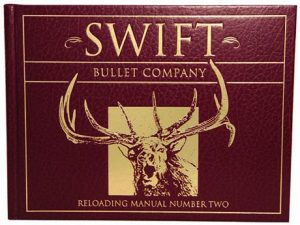Review by Larry S. Sterett | Contributing Editor

SWIFT RELOADING MANUAL NUMBER TWO, by the Swift Bullet Company. ©2014. Published by Swift Bullet Company, Dept. TGM, PO Box 27, Quinter, KS 67752. Price: $39, plus shipping. At some storefront and Internet booksellers, or phone: 785-754-3959.
This 470-page volume is bound in reddish-color simulated leather, and features 24k gold leaf lettering and a bull elk on the cover. The end papers consist of the Swift Bullet Company trademark repetitions, leaving no doubt as to the identity of the handbook producer. There is no usual introduction or prologue, but a “special thanks” to some 34 firms and individuals who helped make the manual possible. This is followed by a recap of the Swift A-Frame and Scuricci II bullets, company history, about the artist (This manual features numerous excellent sketches of game species by Adam Freeman.), and five dozen illustrated pages on handloading. (An excellent photo illustrating the difference between Berdan and Boxer primed cases is shown, with the comment “Do not try to size a Berdan primed case in a conventional sizing die.” Actually, sizing is possible with a regular die, PROVIDING you remove the decapping punch and stem from the die assembly first. Otherwise, damage to the decapping pin, or the Berdan case, or both, will result. Decapping a Berdan case requires a special manually-operated decapping tool designed for such cases. There is another method possible, but it’s labor intensive, and using regular Boxer-primed cases is much simpler if they can be obtained in the correct caliber.)
Loading data is provided for more than 80 rifle cartridges, from the .223 Remington to the .500 Nitro Express 3”, and six handgun cartridges, from the .357 Magnum to the .500 Smith & Wesson Magnum. The .357 Magnum, which has been around since 1935, is considered by many handgun hunters as the smallest caliber suitable for game hunting up to whitetail size. The .41 Remington Magnum is probably a slightly better choice for hunting than the 357, and loaded with a 210-grain Swift A-Frame to some 1300+ feet/second it’s a good whitetail/mule deer cartridge.
Loading data is presented for the various Swift bullets of a specific caliber with a variety of suitable powders. The test components, case brand used, primer brand and size, brand of test barrel, length, and twist, for each cartridge is listed, along with the sectional density and ballistic coefficient for the specific bullet used. The powder—brand and weight in grains—is listed along with velocity for each load, energy, bullet path, and deflection @ 10 MPH out to 500 yards for the rifle cartridges. (Handgun ballistics extend only to 400 yards, where the 325-grain bullet from the 500 S&W Magnum may drop more than a dozen feet if zeroed in a 100 yards.
Handloaders will not find loading data for every cartridge out there. This is a manual for loading cartridges used for hunting, from small game to the big African variety. The late Colonel Askins has a liking for the 8mm Remington Magnum, and used it in Africa. Starting with this cartridge there are loads listed for three dozen cartridges of this and larger calibers. A few, such as the .348 Winchester, .358 Winchester, and .45-70 Government, might be questionable for African use, but most of the others, including the .405 Winchester—TR’s lion medicine, have seen use on the Dark Continent. Data for the three major 9.3mm cartridges is provided, in addition to data for seven .338 cartridges, four .375 cartridges, four .416 cartridges, . Jeffrey, .470 Nitro Express, .505 Gibbs, and the .500 Nitro Express 3”. Cartridges launching a 500-grain, or heavier, bullet downrange, and for which loading data is provided, include .458 Winchester Magnum, .458 Lott, .460 Weatherby Magnum, .470 Nitro Express, and .500 Nitro Express 3”.
In addition to the loading data provided, the stats—ballistic coefficient, sectional density, length, and weight–on the bullets used is listed, along with sectioned cartridge drawings of the cartridge with representative bullets loaded. Distributed throughout the manual are Adam Freeman’s game drawings—goats, pronghorns, bears, bison, sheep, moose, buffalo, hippos, lion, rhinos, wildebeest, cheetah, elephant, mule and whitetails, caribou, coyote, lynx, and more. There are even drawings point-of-aim for a representative cartridge—.300 SWM and .300 Winchester Magnum—out to 400 yards, and how to hold for uphill and downhill shots.
Swift Bullets are first class, and so is this loading manual. The first manual was excellent, but this one has loading data for more cartridges using the newest powders and bullets available. If you handload for any of the big-bore hunting calibers this is the manual to have on your reference shelf. Data for the .50 BMG is not featured, nor are any of the cartridges considered tactical, other than possibly the .223 Remington (5.56mm), .308 Winchester (7.62mm) and .338 Lapua Magnum.



